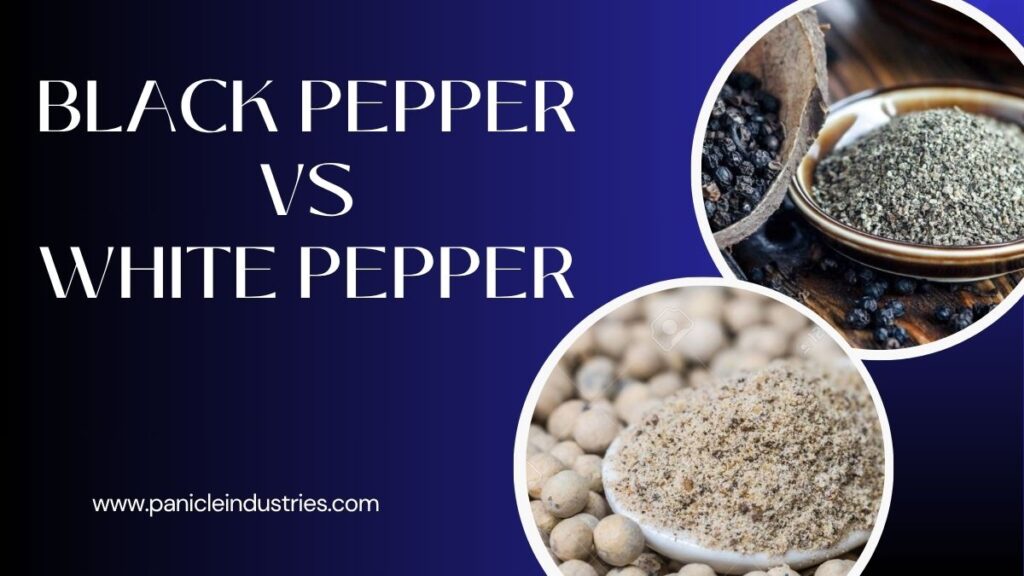Spices are an essential part of cooking, and among them, pepper is one of the most commonly used. When we hear the word “pepper,” black pepper usually comes to mind. But did you know there is also white pepper? Many people are curious about the difference between the two.
In this blog, we will explore the topic of black pepper vs white pepper in detail. While both come from the same plant, they are processed differently, taste different, and are used in different types of recipes. Understanding these differences can help you choose the right kind of pepper for your dishes. Let’s take a closer look at black pepper and white pepper, their benefits, uses, and how they compare to each other.
What Is Black Pepper?
Black pepper is made from the unripe green berries of the Piper nigrum plant. These berries are boiled briefly and then dried in the sun. During the drying process, the outer skin shrinks and turns black, giving black pepper its unique appearance.
Flavor and Aroma
Black pepper has a strong, sharp, and slightly spicy flavor. Its aroma is bold and pungent, making it perfect for a variety of savory dishes.
Common Uses
Black pepper is used in:
- Soups and stews
- Curries
- Marinades
- Egg dishes
- Salads and dressings
It is also a common table spice, often paired with salt.
Also read: Rice Bran Oil vs Seed Oil
What Is White Pepper?
White pepper also comes from the same plant, but it is made differently. The berries are allowed to ripen fully on the plant until they turn red. The outer skin is then removed by soaking the berries in water for several days. After removing the skin, the inner seed is dried to make white pepper.
Flavor and Aroma
White pepper has a milder, slightly earthy, and musty flavor compared to black pepper. It is less pungent but still provides heat.
Common Uses
White pepper is often used in:
- White sauces
- Light-colored soups
- Mashed potatoes
- Chinese and Thai cuisine
- Cream-based dishes
Because it doesn’t have a black outer shell, it blends well in dishes where black specks might look unappealing.
Black Pepper vs White Pepper: Key Differences
Let’s explore the main differences between black pepper and white pepper:
Processing Method
- Black Pepper: Made from unripe berries with the outer shell dried and left intact.
- White Pepper: Made from ripe berries with the outer skin removed.
Appearance
- Black Pepper: Dark, wrinkled outer layer.
- White Pepper: Smooth, pale or white-colored seeds.
Taste
- Black Pepper: Bold, hot, and spicy.
- White Pepper: Mild, earthy, and slightly fermented taste.
Aroma
- Black Pepper: Strong and sharp aroma.
- White Pepper: Less intense, more subtle fragrance.
Culinary Uses
- Black Pepper: Used in almost all kinds of savory dishes.
- White Pepper: Preferred in light-colored sauces and dishes for visual appeal.
Health Benefits of Black and White Pepper
Both types of pepper offer health benefits as they contain piperine, a natural compound known for its antioxidant and anti-inflammatory properties.
Benefits of Black Pepper
- Boosts digestion: Stimulates digestive enzymes.
- Improves nutrient absorption: Helps the body absorb vitamins and minerals better.
- Supports weight loss: Increases metabolism slightly.
- Fights free radicals: Acts as an antioxidant.
Benefits of White Pepper
- Aids digestion: Similar to black pepper, it supports gut health.
- Relieves cough and cold: Used in home remedies for colds.
- Improves appetite: Stimulates the taste buds.
- Contains antioxidants: Helps fight cell damage.
Culinary Tips for Using Black and White Pepper
How to Use Black Pepper in Cooking
- Add black pepper while cooking to enhance the overall flavor.
- Use freshly ground black pepper for stronger aroma and taste.
- Sprinkle on salads, grilled meats, or eggs before serving.
How to Use White Pepper in Cooking
- Add white pepper in sauces, soups, or mashed potatoes for a smooth look.
- Use in Chinese or Thai dishes for authentic flavor.
- Be cautious with quantity—white pepper can have a strong aftertaste if overused.
Which One Should You Use?
When it comes to black pepper vs white pepper, the answer depends on your recipe and taste preference.
Use Black Pepper If:
- You want bold, spicy flavor.
- You’re cooking dark or colorful dishes.
- You want a more common and versatile spice.
Use White Pepper If:
- You’re making white sauces, soups, or creamy dishes.
- You prefer a milder flavor.
- You want a smooth, uniform appearance in the final dish.
Storage Tips for Pepper
To keep your pepper fresh and flavorful, follow these simple tips:
- Store in airtight containers: Prevents moisture and preserves aroma.
- Keep away from direct sunlight: Store in a cool, dark place.
- Use whole peppercorns when possible: Grind just before use for better flavor.
- Check expiry dates: Ground pepper loses its aroma faster than whole peppercorns.
Can You Substitute One for the Other?
Yes, black and white pepper can sometimes be used as substitutes, but keep the following in mind:
- Flavor Change: Black pepper is stronger; white pepper is milder.
- Color Change: White pepper will not leave black specks in food.
- Taste Preference: In delicate recipes, like cream-based soups, use white pepper. For strong-flavored dishes, use black pepper.
If exact flavor or color matters to your dish, it’s better to stick to the pepper the recipe calls for.
Conclusion
In conclusion, understanding the difference between black pepper vs white pepper can help you make better choices in your kitchen. While both come from the same plant, their processing methods, flavors, and uses are quite different. Black pepper is bold, strong, and perfect for most everyday dishes. White pepper, on the other hand, is milder and ideal for light-colored or delicate recipes. Both offer great health benefits and add depth to your cooking.
Knowing when and how to use each type can improve the taste and appearance of your meals. So next time you cook, choose the right pepper to match your dish and elevate your flavor game.


